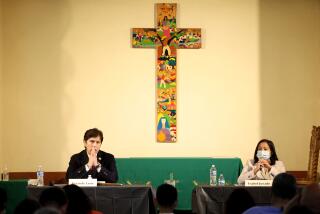Valley Support Crucial to Success of Police Plan : Voters Should Be Open to New Tax if City Waste Trimmed
- Share via
Mayor Richard Riordan’s and Police Chief Willie L. Williams’ recent visit to the San Fernando Valley included quite an entourage. There was Bill Violante, deputy mayor for police services; Rabbi Gary Greenebaum, president of the Police Commission; Bill Ouchi, a special adviser on reorganizing city government, and Cecilia Aguilera, the mayor’s top field representative in the Valley.
This was hardly overkill. The occasion was a Van Nuys breakfast before the Valley Industry and Commerce Assn. (VICA) in which Riordan and the chief pitched their elaborate (and expensive) plan to boost the size of the city’s woefully undermanned police force. The police plan is expected to cost as much as $300 million annually.
Because of that cost, and uncertainties over its financing, it is widely suspected that new taxes will be required to pay for the plan, at least in part. For that reason alone, the Valley is crucial to building support for the police buildup package. Valley voters played the major role last April in defeating a measure that would have levied a new property-type tax to pay for 1,000 more officers.
A gauge of sentiment in the Valley and Los Angeles County as a whole will come Tuesday, when voters cast their ballots on Proposition 172. That is the statewide measure that would keep in place a current half-cent sales tax that funds public safety projects, particularly those involving law enforcement.
Those present at the VICA breakfast said that the region’s residents don’t believe that current city funding is being used efficiently throughout the government. That sentiment is understandable, but it should not manifest itself in a rejection of Proposition 172, or in premature coolness to Riordan’s police plan.
The mayor and Chief Williams have developed a serious and complex plan that addresses a badly needed personnel buildup for the force. Los Angeles has one of the nation’s lowest ratios of cops to citizens.
It goes beyond the hiring and training of rookie officers to include recruiting from other departments and moving more civilians into police desk jobs. Labor-saving automation and computerization are also part of the program, along with a judicious use of overtime and holiday buybacks to get more out of the current force.
The mayor has even lobbied the Clinton Administration for a big share of its proposed 50,000-member police corps. Riordan was right in putting in his request, because Washington has delivered little to Los Angeles since the riots. It also made sense because Congress, in a recent airport-protectionist vote, appeared to scuttle the option of using airport revenue to foot the bill.
Valley residents should also appreciate the plan’s emphasis on community-oriented policing, which is unavoidably labor intensive.
Riordan knows that he will have to reduce waste in city departments before asking voters to consider new taxes. If proof of such streamlining and efficiency is forthcoming, the Valley ought to at least be willing to consider the need for new revenues for a beefed-up LAPD.
More to Read
Sign up for Essential California
The most important California stories and recommendations in your inbox every morning.
You may occasionally receive promotional content from the Los Angeles Times.










